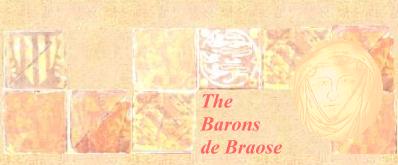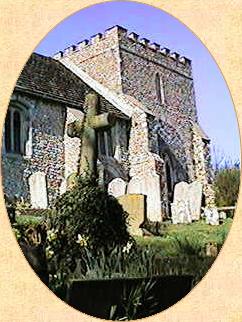
Two
Abbeys
 The
imposing "caput" of William de Braose's barony at Bramber
began to sprawl across the Saxon landscape. Local rights and
customs became subordinate to his will. He built a large wooden
bridge over the river at Bramber and established his own port
there. (4.1) The ships using Saint Cuthman's
Port were forced to pay a toll to William de Braose before they
could reach their destination.
The
imposing "caput" of William de Braose's barony at Bramber
began to sprawl across the Saxon landscape. Local rights and
customs became subordinate to his will. He built a large wooden
bridge over the river at Bramber and established his own port
there. (4.1) The ships using Saint Cuthman's
Port were forced to pay a toll to William de Braose before they
could reach their destination.
In 1085 the King belatedly
confirmed Fécamp
Abbey's claims
to Saint Cuthman's Church, with the income from its three manors
including Steyning. A rival force was planning expansion in William
de Braose's domains and threatened his baronial supremacy.
Naturally he opposed it but the abbey was more than equal to
the fight.
In an aggressive claim
for burial fees, the monks challenged Bramber's right to bury
its parishioners in the churchyard at Saint Nicholas. This was William de Braose's new church, built
to serve the castle.
In 1086 the King called
his  sons, barons and bishops to court
to settle the dispute, which took a full day. The Abbey of Fécamp
swayed the court in its favour and William de Braose had to organise
an exhumation of all the bodies, which must have been an unpleasant
and distressing event. (4.2)
sons, barons and bishops to court
to settle the dispute, which took a full day. The Abbey of Fécamp
swayed the court in its favour and William de Braose had to organise
an exhumation of all the bodies, which must have been an unpleasant
and distressing event. (4.2)
Fécamp's victory
meant that Bramber's dead were all moved to the churchyard at
Saint Cuthman's. William de Braose also lost the right to charge
the abbey tolls at his bridge and the port of Bramber failed
to thrive. Fécamp fought him and won over a rabbit warren,
a park, gardens, a causeway and a channel to fill his moat which
had all encroached onto the abbey's land.
The monks celebrated their
reinstated income by ostentatiously rebuilding Saint Cuthman's Church. They rededicated it to Saint Andrew and transported
Saint Cuthman's relics to Fécamp Abbey.
This was the first of several
legal battles. The dispute was exacerbated by Sele Priory in
Upper Beeding. William de Braose's attempt to form a college
of secular canons at Saint Nicholas' Church in 1073 failed, as
at Briouze. After 1080 he made improved arrangements at
Sele which again mirrored those in Briouze.
 Like
most Norman lords, he felt a pressing need for prayers to be
said regularly to redeem his sins and to assist the souls of
his family. It had become fashionable to establish religious
foundations for this purpose. Obviously the monks at Steyning
would not be invited to do the job, so William's patronage went
to rival Benedictines from the Saint Florent Abbey of Saumur
in Anjou, which must have impressed him greatly.
Like
most Norman lords, he felt a pressing need for prayers to be
said regularly to redeem his sins and to assist the souls of
his family. It had become fashionable to establish religious
foundations for this purpose. Obviously the monks at Steyning
would not be invited to do the job, so William's patronage went
to rival Benedictines from the Saint Florent Abbey of Saumur
in Anjou, which must have impressed him greatly.
Saint Florent established
the Priory of Sele at Upper Beeding and the two abbeys of Fécamp
and Saint Florent then set about disputing eachother's rights
as neighbours for several centuries to come.
The Sele Priory was sited
over the river from Steyning and Bramber. Saint Peter's Church
still stands on the same spot but the private buildings which
adjoin it show little trace of the original priory. William handed
Saint Nicholas' at Bramber, Saint Botolph's, Saint Nicholas'
in Old Shoreham and other churches within the rape to the monks
of Saint Florent.

back to text

back to text

back to text
In 1085 the King belatedly confirmed Fécamp Abbey's claims to Saint Cuthman's Church, with the income from its three manors including Steyning. A rival force was planning expansion in William de Braose's domains and threatened his baronial supremacy. Naturally he opposed it but the abbey was more than equal to the fight. In an aggressive claim for burial fees, the monks challenged Bramber's right to bury its parishioners in the churchyard at Saint Nicholas. This was William de Braose's new church, built to serve the castle. In 1086 the King called
his Fécamp's victory meant that Bramber's dead were all moved to the churchyard at Saint Cuthman's. William de Braose also lost the right to charge the abbey tolls at his bridge and the port of Bramber failed to thrive. Fécamp fought him and won over a rabbit warren, a park, gardens, a causeway and a channel to fill his moat which had all encroached onto the abbey's land. The monks celebrated their reinstated income by ostentatiously rebuilding Saint Cuthman's Church. They rededicated it to Saint Andrew and transported Saint Cuthman's relics to Fécamp Abbey. This was the first of several legal battles. The dispute was exacerbated by Sele Priory in Upper Beeding. William de Braose's attempt to form a college of secular canons at Saint Nicholas' Church in 1073 failed, as at Briouze. After 1080 he made improved arrangements at Sele which again mirrored those in Briouze.
Saint Florent established the Priory of Sele at Upper Beeding and the two abbeys of Fécamp and Saint Florent then set about disputing eachother's rights as neighbours for several centuries to come. The Sele Priory was sited over the river from Steyning and Bramber. Saint Peter's Church still stands on the same spot but the private buildings which adjoin it show little trace of the original priory. William handed Saint Nicholas' at Bramber, Saint Botolph's, Saint Nicholas' in Old Shoreham and other churches within the rape to the monks of Saint Florent.
|
||||||